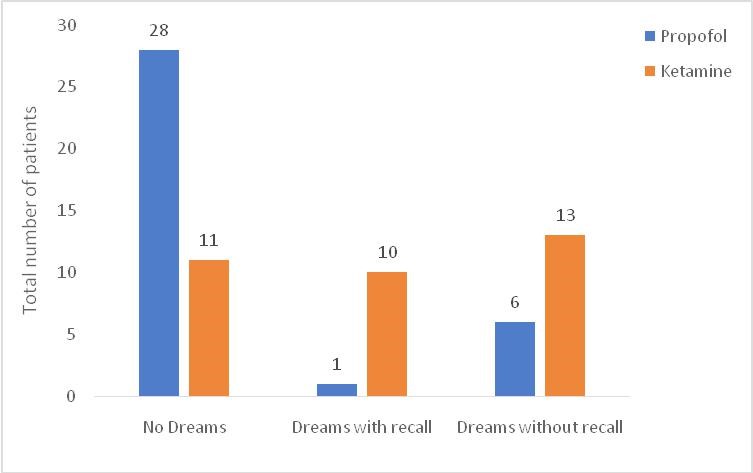Abstract
Background:
Dreaming during anaesthesia is a common phenomenon. Dreams can occur with both inhalational agents as well as intravenous agents (IVA) like propofol and ketamine. But there are concerns like patient awareness, dreams and other untoward effects that may be associated with
IVA. We have conducted this study to quantify the incidence of dreaming during IVA with propofol or ketamine.
Methods:
Sixty-nine patients aged
18 to 60 years scheduled for short procedures lasting from 5 to 25 minutes under IVA were randomized into two groups – group propofol or group ketamine. All the patients received midazolam and fentanyl intravenously. Then, patients in group propofol received propofol and those in ketamine group received ketamine for induction and maintenance of anaesthesia. After the end of surgery, when the patient were fully recovered from anaesthesia, patients were interviewed about occurrence of dreams and their ability to
recall the dreams.
Results:
There were 35 patients in group propofol and 34 patients in group ketamine. The incidence of dreaming during anaesthesia was greater in patients of ketamine group, 23 (67.65%), when compared to propofol group, 7 (20%) (p < 0.001). Among the dreamers, 6 patients in the ketamine group and only 1 patient in the propofol group were able to recall
their dream.
Conclusion: Dreaming is quite common during IVA for short surgical procedure, more so following ketamine than propofol anaesthesia.
References
2007 Jan;106(1):33–42.
2. Hellwagner K, Holzer A, Gustorff B, Schroegendorfer K, Greher M, Weindlmayr-Goettel M, et al. Recollection of dreams after short general anaesthesia: influence on patient anxiety and satisfaction. Eur J Anaesthesiol. 2003;20(4):282–8.
3. Brandner B, Blagrove M, McCallum G, Bromley LM. Dreams, images and emotions associated with propofol anaesthesia.
Anaesthesia. 1997 Aug;52(8):750–5.
4. Kasmacher H, Petermeyer M, Decker C. [Incidence and quality of dreaming during anesthesia with propofol in comparison with enflurane]. Anaesthesist. 1996 Feb;45(2):146–53.
5. Errando CL, Sigl JC, Robles M, Calabuig E, Garcia J, Arocas F, et al. Awareness with recall during general anaesthesia: a prospective observational evaluation of 4001 patients. Br J
Anaesth. 2008 Aug;101(2):178–85.
6. Leslie K, Myles PS, Forbes A, Chan MT V, Swallow SK, Short TG. Dreaming during anaesthesia in patients at high risk of awareness. Anaesthesia. 2005 Mar;60(3):239–44.
7. Myles PS, Leslie K, McNeil J, Forbes A, Chan MT V. Bispectral index monitoring to prevent awareness during anaesthesia: the B-Aware randomised controlled trial. Lancet (London, England).
2004 May;363(9423):1757–63.
8. Sebel PS, Bowdle TA, Ghoneim MM, Rampil IJ, Padilla RE, Gan TJ, et al. The incidence of awareness during anesthesia: a multicenter United States study. Anesth Analg. 2004
Sep;99(3):833–9.
9. Stait ML, Leslie K, Bailey R. Dreaming and recall during sedation for colonoscopy. Anaesth Intensive Care. 2008 Sep;36(5):685–90.
10. Eer AS, Padmanabhan U, Leslie K. Propofol dose and incidence of dreaming during sedation. Eur J Anaesthesiol. 2009
Oct;26(10):833–6.
11. Vinnik CA. Dissociative anesthesia in an office-based plastic surgery practice. Semin Plast Surg. 2007 May;21(2):109–14.
12. Sarasso S, Boly M, Napolitani M, Gosseries O, Charland-Verville V, Casarotto S, et al. Consciousness and Complexity during Unresponsiveness Induced by Propofol, Xenon, and Ketamine.
Curr Biol. 2015 Dec;25(23):3099–105.
13. Cheong SH, Lee KM, Lim SH, Cho KR, Kim MH, Ko MJ, et al. Brief report: the effect of suggestion on unpleasant dreams induced by ketamine administration. Anesth Analg. 2011
May;112(5):1082–5.
14. Miller TE, Gan TJ. Total intravenous anesthesia and anesthetic outcomes. J Cardiothorac Vasc Anesth. 2015 Jun;29 Suppl 1:S11-5.
15. Hall CS, Van de Castle RL. The content analysis of dreams [by]
Calvin S. Hall and Robert L. Van de Castle. New York: Appleton-Century-Crofts; 1966.
16. Winget C. KM. Dimensions of Dreams. Univ Florida Press. 1979;
17. Zacny JP, Lichtor JL, Coalson DW, Finn RS, Uitvlugt AM, Glosten B, et al. Subjective and psychomotor effects of subanesthetic doses of propofol in healthy volunteers. Anesthesiology. 1992
May;76(5):696–702.
18. Blagrove M, Morgan CJA, Curran HV, Bromley L, Brandner B. The incidence of unpleasant dreams after sub-anaesthetic ketamine. Psychopharmacology (Berl). 2009 Mar;203(1):109–20.
19. Hejja P, Galloon S. A consideration of ketamine dreams. Can
Anaesth Soc J. 1975 Jan;22(1):100–5.
20. White PF, Way WL, Trevor AJ. Ketamine--its pharmacology and therapeutic uses. Anesthesiology. 1982 Feb;56(2):119–36.
21. Leslie K, Skrzypek H. Dreaming during anaesthesia in adult patients. Best Pract Res Clin Anaesthesiol. 2007 Sep;21(3):403–
14.
22. Grace RF. The effect of variable-dose diazepam on dreaming and emergence phenomena in 400 cases of ketamine-fentanyl anaesthesia. Anaesthesia. 2003 Sep;58(9):904–10.
23. Handa F, Tanaka M, Nishikawa T, Toyooka H. Effects of oral clonidine premedication on side effects of intravenous ketamine anesthesia: a randomized, double-blind, placebo-controlled study.
J Clin Anesth. 2000 Feb;12(1):19–24.

